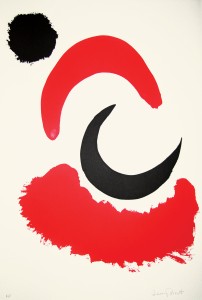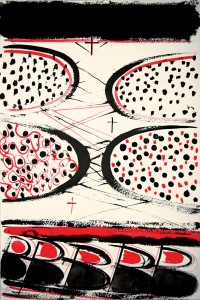
A dramatic exhibition of Terry Frost’s prints from his Lorca Suite is currently on show in the De’Longhi Print Room at Pallant House Gallery in Chichester, West Sussex.
It focuses on the British abstract artist Terry Frost and his engagement with the poetry of the Spanish poet, playwright and theatre director Federico García Lorca. Lorca became one of the first martyrs of the Republican cause in the Spanish Civil War when he was killed by fascist Nationalist rebels in 1936. Assistant Curator Katy Norris explains, “Lorca’s death has come to epitomise the violent suppression of the intellectual left by right-wing partisans.” When General Franco seized power in 1939, at the end of the conflict, he banned Lorca’s work from publication in Spain.
During the Second World War Terry Frost was a prisoner of war under the Nazis and a victim of fascism. Katy keenly describes how this loss of freedom awakened his political and artistic consciousness, an experience which would inform his life and work, saying: “Frost exercised a lifelong pursuit of his artistic right to freedom of expression.”

Frost would later acknowledge how, as a prisoner, his hunger and suffering gifted him with “a tremendous spiritual experience [and] a more heightened perception”. The artist described this formative experience as “an awakening”. Katy adds: “Frost discovered his profound sense of connection with nature and landscape at this time.”
The liberal society in which Terry Frost was working in the 1970s and 1980s was certainly in complete contrast to Franco’s earlier repressive regime. Frost would return to Lorca’s work over a fifteen-year period, creating paper collages, drawings and prints in response to the writer’s work. It culminated in the portfolio of coloured etchings on display here. Produced in 1989 and titled Eleven Poems by Federico García Lorca, they have become known as the Lorca Suite. Together these images, each based on a specific poem, provide a visual window illuminating Lorca’s writing.
Lorca’s writing employs an economy of vocabulary. In these poems life is stripped back, allowing clarity of vision expressive of the author’s heightened perception. This writing is filled with ambiguity and a lack of fulfilment, which gifts it with space and nobility.

This distance between the artistic representation and the reality of the subject would give Frost space for freedom of expression. Terry Frost, like Lorca, also distilled the world around him. He, too, used a carefully conceived vocabulary, though Frost’s was one of colour, light and form in the abstract.
I remark on the dramatic hues of black, white and red which are apparent in many of these works. Katy responds, “Lorca used black, white and red to describe the blazing light and heat of the Mediterranean sun. In the 1960s Frost had begun to use these colours in relation to the Spanish landscape, years before engaging with Lorca’s writing. However, it is in the Lorca Suite that we perhaps see his most sophisticated use of this colour scheme.”
This is clearly illustrated in The Spinster at Mass and The Moon Rising. I am drawn to the emblematic etching Lament for Ignacio Sánchez Mejías. Sánchez and Lorca were friends. The matador Sánchez died in the bullring. Lorca’s awareness of death informed his creative spontaneity in this poem; its repetitive rhythm informs this lament. Take, for example, these lines:
“Oh white wall of Spain!
Oh black bull of sorrow!
Oh hard blood of Ignacio!”
Katy Norris reflects on the economy of colour, shapes and form used to the same dramatic effect in Terry Frost’s etching of the same title. She says: “The black of the bull’s horn and the red blood of Ignacio against the white ground echo the description in Lorca’s poem. The action takes place beneath a setting sun represented by a pulsating yellow disc in the etching.”
The drama and tragedy of the Spanish Civil War and the life and death of Lorca are captured with real intensity in Terry Frost: Eleven Poems by Federico García Lorca. Entrance to this exhibition is free but it is worth treating yourself to tickets for Conscience and Conflict: British Artists and the Spanish Civil War. Both exhibitions run until 15th February 2015 at Pallant House Gallery, 9 North Pallant, Chichester, PO19 1TJ. For more information go to www.pallant.org.uk or telephone 01243 774557. You must add them to your 2015 New Year’s must-see list!
By Revd. Rupert Toovey. Originally published on 28th December 2014 in the West Sussex Gazette.